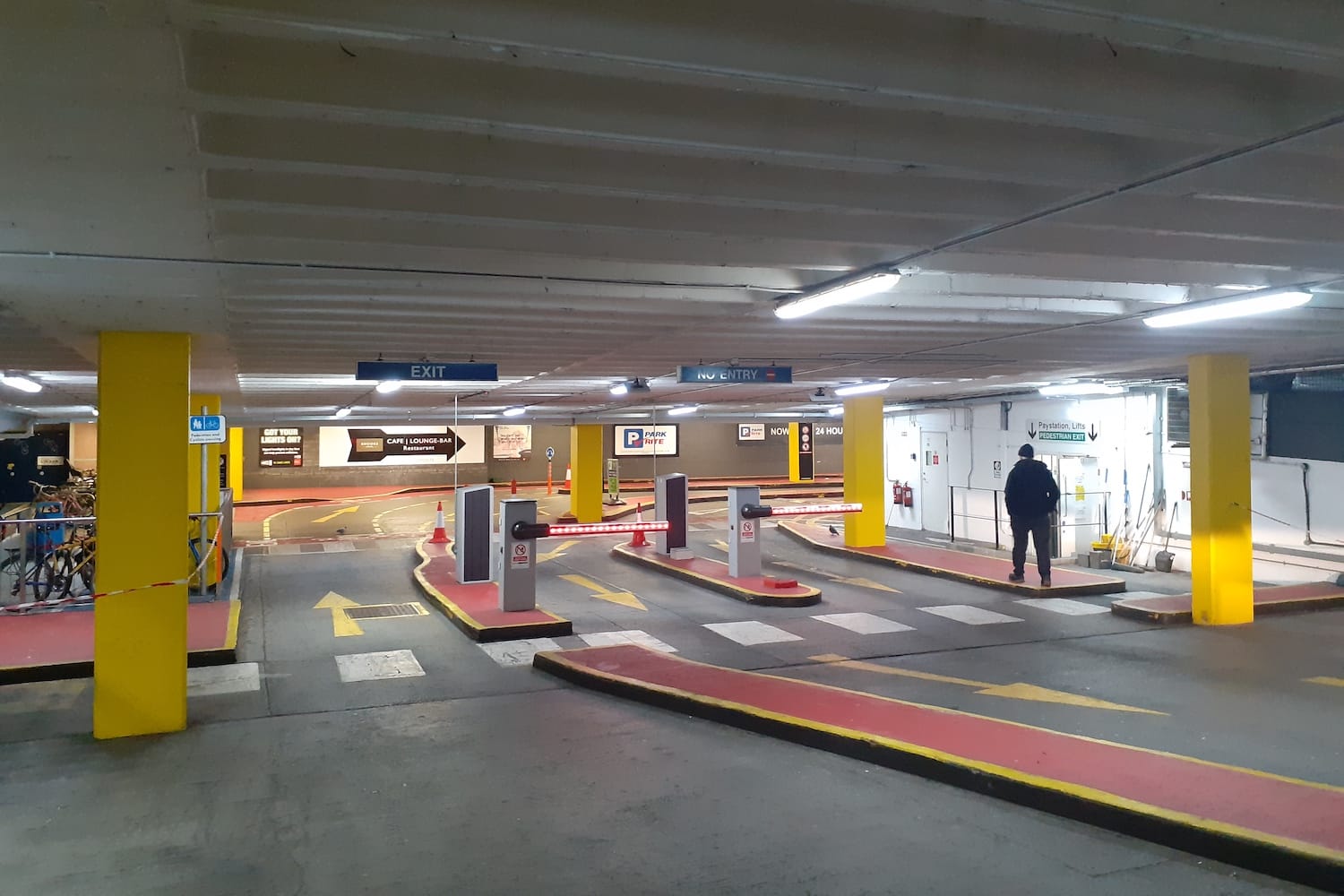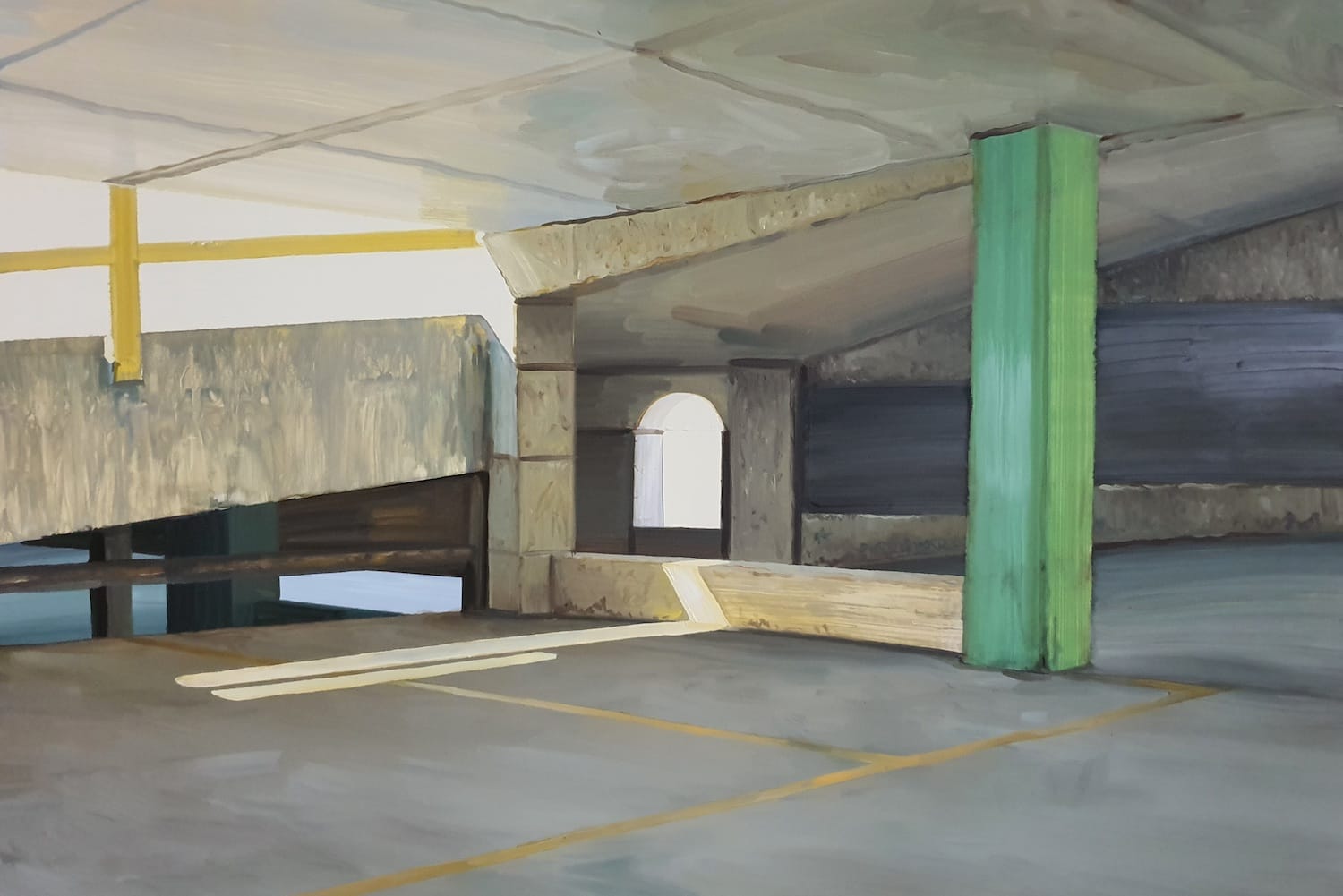What’s the best way to tell area residents about plans for a new asylum shelter nearby?
The government should tell communities directly about plans for new asylum shelters, some activists and politicians say.
John O’Reilly started with graffiti in his teens, and then eventually moved into oils. His paintings of car parks are on show at Glovebox, a car-park gallery, until March.

John O’Reilly cranes his head left and right beside a canary yellow pillar bearing some of the load of the floors of the Drury Street Car Park above.
Looking towards the entrance barriers, he spots the angle that inspired his first painting of inside a car park.
It was the colour that first drew him in then, he says, as it still does 11 years on.
On the floor either side of the entrance barriers of the car park, are slabs of red and yellow chicanes.
They look nice, says O’Reilly. “To have such bright colours, in kind of a drab place.”
On the wall behind is a sheen of light from a hidden exit. He painted that too, he says, so “the imagination or the eye can have somewhere to go”.
The geometry and composition grabs him. “You have the arrows, and the white zebra thing, vertical pillars and horizontal lines,” he says, and points up at the ceiling and its repeating pattern of steel bars.
Most people overlook car parks as drab and cold places to draw up into and get out of fast. But they’re more interesting than at first glance, O’Reilly says.
He’s focused on them again and again since he started painting in his mid-twenties and he still finds them fascinating, he says.
Car parks are changing, says O’Reilly, but he wants to preserve what they were built for in his art.
O’Reilly grew up in North Strand. He started out at graffiti when he was 16 and kept it up until he was 27, occasionally getting offers to paint in places like New York, London, Italy and Australia, he says.
Artist friends and family inspired him to pick up oil painting. “I just started painting areas that I would have painted graffiti in or the area I grew up in,” he says.
Buildings and industrial areas hooked him, he says. “Because you’re wandering the city a lot, so it was just natural to go and paint those subjects.”
Dublin Port, with its huge silos, fuel tankers, and pipes is a favourite. A different world, he says.
Drury Street Car Park was the first car park he took more notice of. Although he doesn’t know much about how car parks are built, or why one colour or another is chosen for the walls, he admires the coarse tones, rigid lines and rough textures.


On the first floor in a dark corner, a flicker of fluorescent light catches O’Reilly’s eye. “There, you have a nice kind of dramatic light, kind of similar to stage lighting.”
He likes the corner. It’s secluded and empty. Perpendicular yellow stripes on the concrete floor lead towards an emergency exit door, which stands ajar. On the dirty yellow pole is a bent metal sign advertising parking fees.
“The chipped paint there in the corners,” says O’Reilly. “The door’s open. There are little things going on there.”
He runs his foot across the jaggedly applied concrete. “There’s some nice textures there, with the ground. It’s got like stains and then it’s got the car tracks from wet tires. The paint and it’s all dirty.”
O’Reilly hikes up and around the steep incline. The car park’s low ceilings, banality and stillness reminds him of sci-fi movies, he says, like an alien place where action will spring out from a corner.
Another level up, the ground trembles. A man sits in a small white van, chewing. He wipes his mouth behind the windshield, the sound of his idling engine shaking the ground.
O’Reilly turns his head to the right to admire the diagonal patterns created by the massive grey steel beams that support the ramps that cars follow to reach the upper levels.
“Just shape-wise, you know? Where shapes start to converge on an aesthetic level, it’s interesting,” he says.
Cobwebs lace through the metal grates between the steel beams. “It shows that, like, there’s some kind of life living here.”
He reaches the next level, to the point directly above the corner he liked below. It’s the same. The door is ajar, the yellow paint is dirty. Wet tire tracks on the concrete.
As the car park rises, the shiny car bonnets thin out. The car park starts to look more like one of O’Reilly’s paintings.
He likes painting car parks as empty. When people think about car parks, it’s about their function, he says, like whether they are full or have free spaces.
With no cars, car parks would feel entirely different, he says. Cold air rushes around and the space feels hollow. “Subconsciously it might feel eerie.”

Car parks are a fragment of the built environment that people have created to get around in their cars. O’Reilly likes motorways, railways and industrial sites for similar reasons. They’re a record of how we function as a society, he says.
City-centre multi-storey car parks may not last into the future, he says. “They might all be on the outskirts of the city and then you just take public transport to go in.”
“Maybe a few decades later, we’ll think, maybe keep one or two of those structures because they’re of our time,” he says.
“An archaeologist in 300 years would probably find interest in this car park because it gives a clue to the day-to-day activity of our civilization,” says O’Reilly.
O’Reilly’s art is to create a record of car parks, he says, to preserve the angles and atmospheres that fascinate him.
But he wouldn’t want his own opinion on the existence of car parks to come through, he says, just his musings on their aesthetic value.
“I wouldn’t want to say, here’s a car park, it’s real depressing looking, it’s dystopian,” he says. “I don’t want to put any value on it.”
On the top floor under the open sky, two large cars are parked a polite distance away from one another. In one, a distant figure eats their lunch.
O’Reilly says when he was younger, it was so exciting sitting in the car while it twisted and turned up and up.
There was something cool about reaching the top, he says. “It’s such a different place. It kind of has a whole different feel out here.”
O’Reilly squints his eyes at the red-brick towers on the rooftop of George’s Arcade. You can technically come here and see the city skyline for free, he says, but that’s not exactly what the top floor is meant for. The walls are too tall for most to see easily over.
“Using an area for something it’s not used for is really interesting. Skateboarders, teenagers might go drinking, people would be using it for play and privacy,” he says.
Since they aren’t invited, some people might feel nervous if it’s too quiet up here, he says, while others would find the isolation relaxing. “It’s a break from all the cacophony, you know.”
But if they were invited, it would be nice, he says. Maybe to a park up here or markets, he says.
“It would be nice to be in town, come up here, chill out, you know,” says O’Reilly, glancing to the east at the cityscape of buildings along Bow Lane.
On the bottom floor, next to the entrance of the Drury Street Car Park is Amy Austin, a wine bar, not far from rows of half-filled bike parking, and a mural in hues of orange, pink and blue.
Glovebox, the art gallery and cocktail lounge where O’Reilly’s paintings are on display until the end of March, opened in December on level 5 of Trinity Street Car Park.
On level 6 of the Trinity Street Car Park, Allta Restaurant opened the same month.
Maybe people find car parks boring because they don’t have any attachment to them, says O’Reilly. “I just like the idea of something being banal, temporary, just being a bit used.”
“You can appreciate some things about it, and like everything, some things about it you might dislike,” he says. “And then it’s probably gonna be gone someday, you know?”